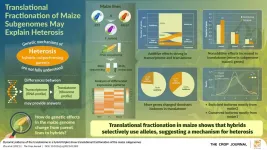(Press-News.org) CHAPEL HILL, NC - A team led by scientists at the UNC School of Medicine identified a molecule called microRNA-29 as a powerful controller of brain maturation in mammals. Deleting microRNA-29 in mice caused problems very similar to those seen in autism, epilepsy, and other neurodevelopmental conditions.
The results, published in Cell Reports, illuminate an important process in the normal maturation of the brain and point to the possibility that disrupting this process could contribute to multiple human brain diseases.
"We think abnormalities in microRNA-29 activity are likely to be a common theme in neurodevelopmental disorders and even in ordinary behavioral differences in individuals," said senior author Mohanish Deshmukh, PhD, professor in the UNC Department of Cell Biology & Physiology and member of the UNC Neuroscience Center. "Our work suggests that boosting levels of miR-29, perhaps even by delivering it directly, could lead to a therapeutic strategy for neurodevelopmental disorders such as autism."
miR-29 and brain maturation
MicroRNAs are short stretches of ribonucleic acid inside cells that regulate gene expression. Each microRNA, or miR, can bind directly to an RNA transcript from certain other genes, preventing it from being translated into a protein. MiRNAs thus effectively serve as inhibitors of gene activity, and the typical microRNA regulates multiple genes in this way so that genetic information is not overexpressed. These essential regulators have been intensively researched only in the past two decades. Therefore, much remains to be discovered about their roles in health and disease.
Deshmukh and colleagues set out to find microRNAs involved in the maturation of the brain after birth, a phase that in humans includes approximately the first 20 years of life. When the scientists looked for microRNAs with more activity in the adult mouse brain than the young mouse brain, one set of miRNA stuck way out from the rest. Levels of the miR-29 family were 50 to 70 times higher in the adult mouse brains than in young mouse brains.
The researchers examined a mouse model in which the genes for the miR-29 family were deleted just in the brain. They observed that although the mice were born normally, they soon developed a mix of problems, including repetitive behaviors, hyperactivity, and other abnormalities typically seen in mouse models of autism and other neurodevelopmental disorders. Many developed severe epileptic seizures.
To get a sense of what caused these abnormalities, the researchers examined gene activity in the brains of the mice, comparing it to activity in mouse brains that had miR-29. As expected, many genes were much more active when miR-29 was no longer there to block their activity. But the scientists unexpectedly found a large set of genes - associated with brain cells - that were less active in miR-29's absence.
A mysterious methylator
With key assistance from co-author Michael Greenberg, PhD, a professor of neuroscience at Harvard University, the researchers eventually found the explanation for this mysterious reduction in gene activity.
One of the target genes that miR-29 normally blocks is a gene that encodes for an enzyme called DNMT3A. This enzyme places special chemical modifications called CH-methylations onto DNA, to silence genes in the vicinity. In mice brains, the activity of the gene for DNMT3A normally rises at birth and then sharply declines several weeks later. The scientists found that miR-29, which blocks DNMT3A, is what normally forces this sharp decline.
Thus, in the mice whose brains lack miR-29, DNMT3A is not suppressed and the CH-methylation process continues abnormally - and many brain cell genes that should become active continue to be suppressed instead. Some of these genes, and the gene for DNMT3A itself, have been found to be missing or mutated in individuals with neurodevelopmental disorders such as autism, epilepsy, and schizophrenia.
To confirm DNMT3A's role, the scientists created a unique mouse model that prevents miR-29 from suppressing DNMT3A, but leaves miR-29's other targets untouched. They showed that this unleashing of DNMT3A on its own results in many of the same problems such as seizures and early death, as seen in the mice without miR-29.
The findings highlight and clarify what seems likely to be a crucial process in shaping the brain late in its development: the switching-off of DNMT3A to free up many genes that are meant to be more active in the adult brain.
"These results are the first to identify miR-29 as an essential regulator of CH methylation, and to show why restricting CH methylation to a critical period is important for normal brain maturation," Deshmukh said.
Deshmukh and colleagues are now following up by studying in more detail how the lack of miR-29 in different sets of brain cells might give rise to such disorders, and more generally they are studying how miR-29's activity is regulated in childhood to fine-tune brain functions, thereby giving humans the traits that make them unique individuals.
INFORMATION:
The Cell Reports paper was co-first authored by Vijay Swahari, Ayumi Nakamura, and Emilie Hollville. Other authors include Hume Stroud, Jeremy Simon, Travis Ptacek, Matthew Beck, Cornelius Flowers, Jiami Guo, Charlotte Plestant, Jie Liang, Lisa Kurtz, Matt Kanke, Scott Hammond, You-Wen He, E.S. Anton, Praveen Sethupathy, Sheryl Moy, and Michael Greenberg.
Chestnut Hill, Mass. (4/6/2021) -- Compact logos can encourage favorable brand evaluations by signaling product safety, according to a new study by researchers at Boston College's Carroll School of Management and Indian Institute of Management Udaipur, who reviewed the opinions of 17,000 consumers and conducted additional experiments with a variety of logos.
The findings reveal that typography -- specifically tracking, or the spacing between letters in a word -- can influence consumers' interpretations of brand logos. Further, the interpretation is influenced by cultural factors, the researchers reported ...
Fossil discoveries often help answer long-standing questions about how our modern world came to be. However, sometimes they only deepen the mystery--as a recent discovery of four new species of ancient insects in British Columbia and Washington state is proving.
The fossil species, recently discovered by paleontologists Bruce Archibald of Simon Fraser University and Vladimir Makarkin of the Russian Academy of Sciences, are from a group of insects known as snakeflies, now shown to have lived in the region some 50 million years ago. The findings, published in Zootaxa, raise more questions about the evolutionary history of the distinctly elongated insects and why they live where they do today.
Snakeflies are slender, predatory insects that are native to the Northern Hemisphere ...
Starting your day by thinking about what kind of leader you want to be can make you more effective at work, a new study finds.
"It's as simple as taking a few moments in the morning while you're drinking your coffee to reflect on who you want to be as a leader," said Remy Jennings, a doctoral student in the University of Florida's Warrington College of Business, who authored the study in the journal Personnel Psychology with UF management professor Klodiana Lanaj.
When study participants took that step, they were more likely to report helping co-workers and providing ...
April 6, 2021, Alexandria, VA - The American Academy of Otolaryngology?Head and Neck Surgery Foundation published the Clinical Practice Guideline: Opioid Prescribing for Analgesia After Common Otolaryngology Operations today in Otolaryngology-Head and Neck Surgery. This specialty-specific guideline provides evidence-based recommendations on postoperative management for pain in common otolaryngologic procedures, with a focus on opioids.
"As otolaryngologist-head and neck surgeons, we can help reduce the risk of opioid use disorder among our patients and their families," said Samantha Anne, MD, MS, Chair of the Guideline Development Group (GDG). "This clinical practice guideline ...
A new large-scale study led by UC Davis Health and UC San Francisco researchers assessed the risks of leukemia in children with Down syndrome. It pointed to stronger than expected associations between Down syndrome and acute myeloid leukemia (AML), one type of blood cancer.
Down syndrome is one of the most common genetic conditions in the U.S. and Canada. According to the U.S. Centers for Disease Control and Prevention, about 6,000 babies with Down syndrome are born in the United States each year. That's approximately one in every 700 babies born in the U.S. and one in 750 newborns ...
Tweets about Russia by Donald Trump during his presidency caused short but noticeable depreciations of the rouble. Meanwhile, the introduction of new sanctions, upon which the president did not comment, had no such effect. This was the finding of a group of researchers, which included Elena Fedorova, Professor of the Faculty of Economic Sciences of HSE University. The group published their findings in in the Journal of Economic Behavior and Organization.
With the growing influence of social media, officials, politicians, and entrepreneurs increasingly express their positions on various issues directly (for example, using Facebook or Twitter), and their messages serve as an independent source of financial and business ...
"On a scale of one to 10, how much pain are you in?"
In a recent study published by the Journal of Pain, co-authored by Elizabeth Losin, assistant professor of psychology and director of the Social and Cultural Neuroscience lab at the University of Miami, researchers found that a patient's pain responses may be perceived differently by others based on their gender.
According to "Gender biases in estimation of others' pain," when male and female patients expressed the same amount of pain, observers viewed female patients' pain as less intense and more likely to benefit from psychotherapy versus medication as compared to men's pain, exposing a significant patient gender bias that could lead to disparities in treatments.
The study consisted of ...
DETROIT - Researchers at Henry Ford Health System have found that workers in construction and other manufacturing jobs are more susceptible for developing carpal tunnel syndrome than those who work in office jobs.
In a retrospective study published in the Journal of Occupational and Environmental Medicine, researchers report that manual labor jobs that require lifting, gripping and forceful wrist motion contribute to higher rates of carpal tunnel syndrome.
Injuries related to carpal tunnel have steadily declined from 1.3 million in 2003 to 900,380 in 2018, according to the most recent figures compiled by the U.S. Department ...
Glycine regulates neuronal activity in the brain
Glycine is the smallest amino acid - one of the building blocks of proteins. It acts also as a neurotransmitter in the brain, enabling neurons to communicate with each other and modulating neuronal activity. Many researchers have focused on increasing glycine levels in synapses to find an effective treatment for schizophrenia. This could be done using inhibitors targeting Glycine Transporter 1 (GlyT1), a protein that sits in neuronal cell membranes and is responsible for the uptake of glycine into neurons. However, the development of such drugs has been hampered ...
The adage goes, "Two is better than one." Well, that might be true for endeavors involving human heads, but when it comes to ears, hybrid maize tends to have a superior advantage over the parental stocks in most cases. This phenomenon, called hybrid vigor or "heterosis," has been used by agriculturalists across ages to create higher-yielding, more resistant varieties of maize all over the world.
But what are the factors contributing to the increased hybrid vigor of maize? Several different genetic models have been proposed to explain heterosis in varied ...




